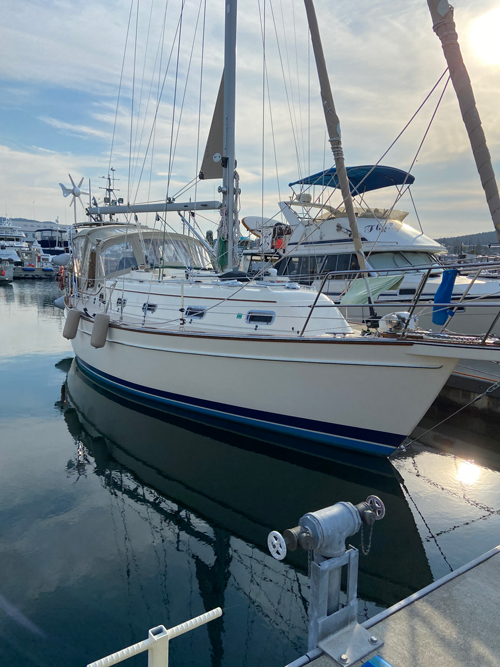This is a guest post by Holly Moxley, an artist and designer, and my dear friend. Holly usually expresses her thoughts and feelings with brushstrokes, but she switched to a pen for this piece. I hope her words will resonate with you as much as they do for me. Thank you, Holly! Happy reading, Deb
I spend a lot of time in my head. As an artist and designer that can be an asset, allowing me to visualize and construct concepts that otherwise remain hidden. But along with it comes overthinking and overanalyzing, and that can be paralyzing to my creative process. Maybe yours too.
Last fall I was offered an opportunity that many would jump at without a second thought—to experience a few days sailing in the Salish Sea. Being true to my in-my-head nature, I imagined barriers (could I leave the studio?, what about that meeting?, who will take care of the dog and the cat?) and invented unlikely scenarios (will I get seasick?, what if there is another “perfect storm”?,) that made me question taking the chance on going.
My friend, and the boat’s skipper, had made the offer several times over the years, but each time there’d been a reason, or an excuse, to decline. This time was no different: the late September weather threatened a possible storm; there are always obligations in work, and life, at home; and Deb’s little old dog’s health (yes, the intrepid Capi you’ve read about) all provided justifications to put off the experience yet another year. But the gloriously extended mild fall of 2022, my amazing staff, and Capi’s fortitude prevailed. As the day approached when I would drive north to Anacortes, the banter in my head finally quieted, and I found myself stepping aboard the beautiful sailing vessel, Kagán.
I noticed the fluidity and comfort with which Deb moved around the tiny and unstable spaces of Kagán, and it gave me a sense of ease. A thorough safety and equipment orientation was a non-negotiable requirement, as well as an impressive introduction to the knowledge of the able captain who would lead our adventure.
We set a course for a three-day cruise of the San Juan Islands that would land us in Friday Harbor where Kagán would be settled for her winter’s sleep. Along the way, Deb shared her knowledge and skill in an approachable, yet awe-inspiring, manner. The unpredictability of the winds and sea, the sheer size and weight of Kagán, as well as wondering what all the other vessels out there could do, might have been an overwhelming opportunity for this overthinker to go overboard—with worry. But Deb’s experience with evaluating and responding to all that was happening around us, provided the same sense of ease underway as it had at the dock. Each time we embarked on a maneuver, Deb gave clear explanations of the steps required to get the job done—like setting the sails, picking up a mooring buoy, or deploying the dinghy. I spent the days on board blissfully outside of my head and in the vastness of nature, savoring the beauty all around me.
And I got to help ease Deb’s worry, about Capi, by holding her and hand-feeding her as she bounced back from a few days’ downturn.

During the days underway and the quiet nights, beneath a blanket of endless stars and above sparkling bioluminescence, Deb and my friendship deepened in Capi’s canine company. Stories, hopes, dreams, and even fears, were shared in the salty air. To my surprise this competent captain also held doubts in the deep corners of her head, including trepidation over the upcoming docking in Friday Harbor. So, we went over the steps carefully. My instructions were clear and Deb assured me I had the tools and knowledge to assist with our arrival at the fuel dock. She was watching everything as we headed into the marina—ferries comings and goings, the water’s surface to see what the current was doing (though she’d already planned to arrive near slack tide), and nearby flags as well as her instruments to check the wind. The harbor was informed of the inexperienced crew (that’s me!), so the dockhand could catch a line, but he was otherwise-engaged with a boat that was really having trouble docking as we pulled up. So, Deb, concentrating but confident (in my reading of it), slid Kagán smoothly up to the dock. I stepped off and cleated the midship line, securing the boat (which Deb had stopped with a little spurt of reverse on the engine, since, as she says, boats don’t have brakes). After shifting the engine into neutral, Deb followed me onto the dock with the stern line. When the dockhand got to us a few minutes later, he said, “You didn’t need me, that was perfect.” And it was!
On the drive home, I got back into my head, but this time to ponder the dichotomy of not feeling confident, but acting as if I did when I helped Deb dock Kagán. That was a powerful lesson that I still hold near—sometimes the best way to overcome an obstacle is to get the heck out of my head.





Holly, I am ecstatic for you! I love how you captured your experience with sailing terms no doubt shared each step of the way by your able captain – and retained. You are amazing as was validated by the crewman at Friday Harbor. I admire you both. I trust Holly might surface as a character in one of Deb’s future novels.